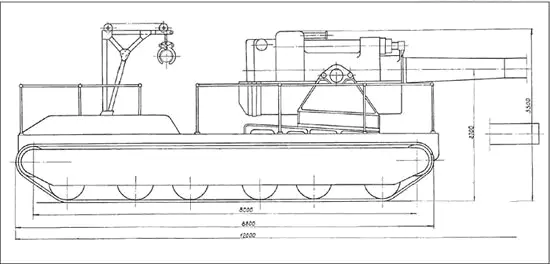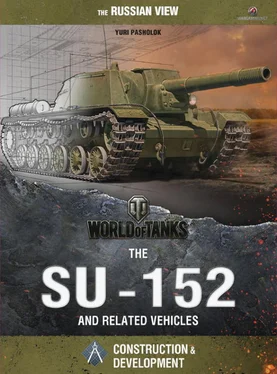
Yuri Pasholok
THE SU-152 AND RELATED VEHICLES
In 2010 the massive, multiplayer online game World of Tanks ( WoT ) was launched by the company Wargaming. At the time this book was published, WoT had more than 80 million registered players worldwide.
The creative people at Wargaming.netare not just tank enthusiasts—they are passionate about the history of armored fighting vehicles (AFVs) and getting them right in the game. In 2012, the company started publishing a series of books in Russian that utilized documents and archival materials that had never before been seen by outsiders or published in any language about the design, procurement, development, manufacturing, and combat employment of Soviet AFVs during World War Two (the Great Patriotic War to Russians).
Now these remarkable books are being published in English with the obvious descriptor The Russian View—English readers may be surprised by some of the opinions of the Russian authors in this series. The series included three categories of titles: Construction and Development (as for the SU-152); Combat Service; and Military Operations.
Yuri Igorevich Pasholok, the author of this book about the SU-152 and other self-propelled (SP) guns based on the KV tank chassis, uncovered intriguing facts and the secret story of Soviet heavy artillery SP guns through his research, including:
• The plan for SP guns began in 1931
• Competition to develop a “bunker buster” SP gun started in earnest in 1938 but just missed battlefield deployment in the 1940 Russo-Finnish Winter War
• Soviet pre-war intelligence indicating that Germany was working on super heavy tanks increased the urgency of the SP program—although the German invasion of the Soviet Union in 1941 showed that intelligence to be wrong
• The impact of evacuating factories and other industry beyond the Ural mountains as German forces advanced
• Joseph Stalin’s personal interest in the SP program and competition between factory design teams for resources and support
• How the destruction of the Barricades factory in Stalingrad (modern day Volgograd) severely reduced Soviet manufacturing of 152 mm and larger guns
• Why SU-152 manufacture stopped after only 670 were produced and why no new heavy SP artillery was deployed to help Soviet armies batter their way through German fortifications in 1944-45
Pasholok’s research provides readers of World War Two history in the West with a much better understanding and greater appreciation of Soviet SP weapon development, and I am extremely fortunate to be able to offer these terrific books for the first time in English.
Dana Lombardy Lombardy Studios September 2015
During the Great Patriotic War the SU-152 SP gun was nicknamed Zveroboy , or “Beast Killer,” in reference to the threat posed by Tigers and other beasts in the German menagerie. According to some accounts, the monster from Chelyabinsk was developed literally over a twoweek period in response to the fielding of heavy tanks by the Germans.
It is true that the first battlefield appearance of the SU-152 coincided with Germany’s extensive use of heavy tanks and tank destroyers. This brainchild of the design bureau headed by Zh. Ya. Kotin proved to be a highly effective weapon against enemy armor from its first engagements. But in actual fact, the history of the Soviet Union’s first mass-produced heavy SP gun began not in late 1941, as some authors have stated, but much earlier. The idea of developing a heavy SP gun for combating reinforced concrete bunkers was born during the Soviet-Finnish War of 1939–1940 and got underway in early 1940. The development of “bunker busters” continued for the next two years, even during the early part of the Great Patriotic War, when the preliminary efforts were transferred from Leningrad to Chelyabinsk and Sverdlovsk. The SU-152 was an act of desperation, because the first chassis for a heavy SP gun had failed to enter mass production. In addition, instead of being used against fortifications, the SU-152 was employed primarily to combat armored vehicles.
This book addresses all of the ups and downs in the history of the development of domestic heavy SP guns based first on the KV tank chassis and then on the KV-1S chassis. A large number of the documents contained in this book are published here for the first time. Documents from the Central Archive of the Ministry Of Defense of the Russian Federation (TsAMO RF) in Podolsk served as the primary sources for the book. Other important sources were documents from the Russian State Archive of Economics (RGAE), the Russian State Archive of Sociopolitical History (RGASPI), and the archive of Factory No. 9 (Yekaterinburg). Materials from the archives of Igor Zheltov, Maxim Kolomiets, Vyacheslav Len, Gennady Malyshev, and Nikolai Shashmurin were also used in the book. The author would also like to thank Sergei Ageyev (Yekaterinburg), whose efforts made it possible to fill in a large number of blanks in the history of the SP guns developed in Sverdlovsk.
Yuri Igorevich Pasholok 2013
CHAPTER 1.
Lessons of the Winter War

B-4 203 mm heavy howitzers on parade in Moscow (RGAKFD).
The story of the development of heavy SP guns in the Soviet Union began in September 1931. The primary goal was to increase the mobility of heavy artillery through mechanization. The SU-7 and SU-14 SP guns were developed during work on a “self-propelled corps-level triplex.” The SU-7 was designed to carry the 152 mm gun, the 203 mm howitzer, and the 305 mm mortar. The SU-14 was designed for the 107 mm gun, the 152 mm gun, and the 203 mm howitzer. Two prototypes were built and assigned the designations SU-14 and SU-14-1. Both systems were initially armed with the B-4 203 mm super-heavy howitzer model 1931, which was later replaced by the BR-2 152 mm heavy gun model 1935. There was talk of starting mass production of the SU-14. The “small triplex” project was canceled on August 7, 1938, after the political arrest of N. N. Magdesiyev (developer of the B-4 howitzer), followed by the arrest of P. I. Syachintov, who headed up the work on the SU-14.

Sketch of the SU-7 from a Plant No. 185 report on its experimental work.
The subject of super-heavy SP artillery came to the fore again in late 1939. On November 30, units of the Red Army crossed the border into Finland, and the conflict that the Finns refer to as the Winter War got underway. The Red Army units quickly encountered the layered defensive line known as the Mannerheim Line. The assault on the line failed. The attacking units, which included tank units, suffered heavy losses, and the offensive bogged down. The Finns managed to hold out until late February 1940. The Mannerheim Line featured a high concentration of defensive structures, some of which could only be put out of action by direct hits from corps-level artillery weapons or super-heavy artillery. The Finns used a large number of antitank artillery guns, which made it difficult to defeat the bunkers. This situation gave rise to an acute need for self-propelled large-caliber guns with armor sufficient to at least protect against small arms and shrapnel.
Читать дальше















